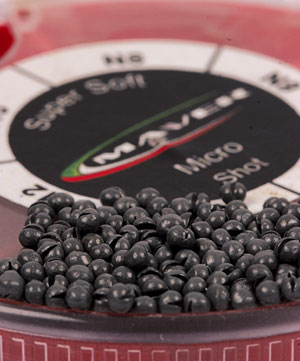Pole Clinic from TCF magazine turns its attentions to shotting patterns for pole rigs
Shotting patterns affect the way a rig performs. It doesn’t matter how good your float and bait are, if your shotting is completely wrong your catch rate will suffer.
Float, bait and shotting all work hand-in-hand to make the ‘perfect’ rig that gives your hook bait a natural look. This is the idea behind this series – to help make you a better pole angler by showing you the correct way to set up your tackle.
Shotting patterns come in various forms. You can use olivettes, shot, styls and now Stotz, depending on what you are trying to achieve and where you are fishing, and we’ll run through the uses for these in this guide.
Yes, the world of shotting patterns can seem daunting at times. Look through any feature in tcf and the angler will talk about the way they have ‘shot’ their rig. Each angler will probably have a different opinion on the best presentation, and the truth is that they all catch lots of fish.
But top England international Will Raison has three words of advice for shotting: “Keep It Simple!”
Why? Because the simpler you keep it, the more confident you will be in your chosen approach. Any confusion you have had will be erased from memory once you start catching, and your rig will be less tangle-prone.
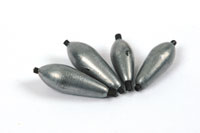
Olivettes
These are large, streamlined weights that are used to take the majority of the weight needed on the rig (commonly known as a ‘bulk’). You can get two types of olivette: inline and pinned.
Inline olivettes normally have a silicon tube passing through the middle, which is where you thread your line. These then slide up and down your line into position until locked in place with shot. They are good for commercial fishery rigs where other olivettes could ping under strain.
The pinned olivettes have short stems protruding from the top and bottom. They are attached to your rig by two small pieces of silicone that slide over the pins. These are prone to pinging off your rig if put under lots of strain. Many manufacturers make olivettes in sizes from 0.2g to huge 10g-plus weights. I prefer inline olivettes and use Trabucco’s inline Drop Master range.
Advantages:
Very accurate
Inline olivettes stay on the line
Pinned olivettes can be changed if needed, without breaking the rig
Disadvantages:
Pinned olivettes can ping off your rig
Inline olivettes need other split shot to make them useable
Large bulk that cannot be split up
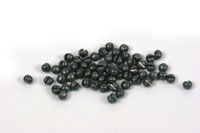
Split Shot
In the smallest of sizes these are lead pellets with a split centrally cut into them. The most commonly used sizes for pole rigs are No8 (0.07g) to No13 (0.01g). The bigger the number, the smaller the shot, but lead is only allowed in sizes No8 or smaller. They can be bulked or spread out to offer different presentations although once using float sizes of a gramme or more, most anglers switch from a bulk of shot to an olivette. The best shot is the softest and most consistent in size and shape. I tend to use the Maver competition shot (in the red dispensers) but even in this shot you can get batches that are quite tough. The best thing to do is have a look in your local shop and see what is the softest at the time.
Advantages:
Large range of sizes
Easy to use
Lots of options for shotting patterns
Disadvantages:
Can get bad batches
Can be fiddly in smaller sizes
Sometimes ping off the line
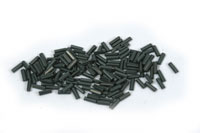
Styls
These are quite specialised and were developed on the Continent by anglers looking for a way of presenting a very light rig without shot. They have a cylindrical shape with the centrally cut split down the long edge. These then sit on the line like long barrels. They have a larger surface area than shot so sink more slowly and are regularly used by canal anglers when fishing on the drop for roach in shallow water. Because they have a large, open split, match carp anglers prefer them as they don’t ping off the line under strain. They are pinched onto the line using styl pincers which you can buy in your local tackle shop. Styls are not as popular as shot.
Advantages:
Don’t ping off line
Very slow-falling in smaller sizes
No ‘shot bites’ when fishing hemp
Disadvantages:
Need special styl pincers to put on the line
Different sizes compared to shots
Not widely available
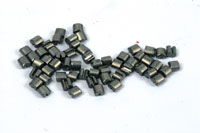
Stotz
Manufactured by Preston Innovations, these are relatively new on the market and are a hybrid between shot and styls. They have a very consistent size, large centrally cut split allowing them to be put onto thicker lines than you can with small shot, and they come in the same popular sizes as shot. Stotz are very popular with match carp anglers who want a lead weight that will not ping off their line under strain. Round shot can easily ping off thickish line under strain.
Advantages:
Large split, ideal for commercial fishery rigs
Will not ping off line
Very consistent size
Disadvantages:
Quite large for their size
Key Patterns
Mark Williams runs through three of his favourite shotting patterns that will stand you in good stead on a variety of venues.
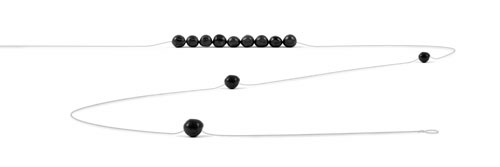
Bulk And Droppers
This is the most common shotting pattern for any angler. It has many guises and can be used to catch all types of fish on the pole. What the bulk-and-droppers pattern provides is speed and finesse. The bulk will take the rig and hook bait near to the bottom very fast. The dropper shot below will then allow you to read the fall of the hook bait to the bottom. The bigger the droppers, the more positive the bite. Canal anglers tend to use small droppers whereas river anglers would use bigger droppers. The better the fishing, the bigger the droppers you can get away with. I have some rigs with one No11 dropper for bagging, and rigs with five droppers for when it’s hard. However, the majority of my rigs have three droppers. The distance these are spread out is largely dependent on the venue. On rivers mine are usually 10cm apart and on canals they are 6cm apart. On commercial fisheries I tend to use one bulk 12 inches from the hook with no droppers. The bulk can also exist in many forms from large groups of shot to a single olivette. As a general rule I use shot as bulks on all floats below 0.8g in size and olivettes above this. It takes a lot of No8 shot for a 0.8g float and even more for a one grammer!
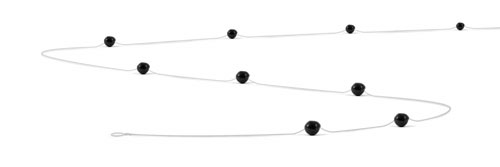
Shirt Button
This shotting pattern is regularly used to catch on the drop. It involves several small shot spread equally from the hooklength upwards. The shot are the same distance apart from each other (like shirt buttons) and they give the hook bait a slow fall. This pattern works well when loosefeeding maggots or casters for roach or rudd. I use this pattern when fishing caster on the canal as I want my hook bait to look as natural as possible, and on clear canals this pattern works better than all the others I have tried. A 4×10 float takes five equally spread No11 shot about 10cm apart. Many anglers use this pattern for fishing shallow for carp with a few spread shot making the hook bait look very similar to the loosefeed. Styls can be used with this pattern as they make the hook bait fall even more slowly through the water column. I would only recommend this pattern be used for depths of up to four feet as it can be quite time-consuming getting a light float to travel through eight feet of water.
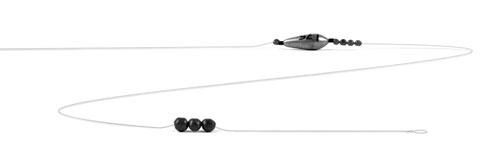
Double Bulk
This is an adaptation of the bulk-and-droppers pattern. It still involves the bulk but it has the droppers moved together to sit just above the hooklength. This is a very positive way of fishing and very useful when bagging small roach that don’t ‘respect’ rig quality. This rig works best with a three-inch hooklength and a carbon-stemmed float. The second bulk should comprise three No10s. When you lay your rig in the first bulk cocks 80 per cent of the float, then as second bulk settles the float dots down to 5mm above the waterline. When the fish picks up the bait it immediately registers on the float by either the float rising up as the fish takes the weight of the second bulk or by the float shooting under as the fish turns and swims away from the pressure. Either way, they are unmissable bites. This pattern sounds great, but only works when there is a large quantity of fish present in your peg.
![]()


